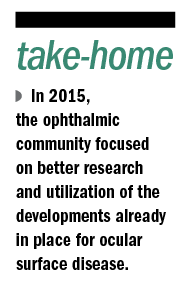Article
Easier ways to identify compromised corneas
Over the past few years, various diagnostics have been introduced to help clinicians identify inflammatory conditions on the ocular surface more readily and, therefore, provide treatment to patients earlier in their disease states.
Reviewed by Peter S. Hersh, MD
Over the past few years, various diagnostics have been introduced to help clinicians identify inflammatory conditions on the ocular surface more readily and, therefore, provide treatment to patients earlier in their disease states.
Dry eye
Clinicians “need to understand, there’s no magic bullet,” said Ernest W. Kornmehl, MD, of Kornmehl Laser Eye Associates, Brookline, MA. Each of the innovations that has been introduced-from topical cyclosporine 0.01% (Restasis, Allergan) to LipiFlow (TearScience)-is not the sole thing that will help a patient, he noted.
Dry eye disease is multifactorial and as a result, specialists must employ multiple modalities to achieve satisfactory results for patients, he said.

The next few years will most likely be a pivotal point in time for ocular surface disease and its impact on vision correction, predicted Jonathan H. Talamo, MD, of Mass. Eye and Ear, Boston.
About 80% of patients suffer from evaporative dry eye as opposed to aqueous-deficient dry eye, so treatment advances in the evaporative sector, such as thermal pulsation of meibomian gland disease (LipiFlow), have great impact.
“It’s not that 2015 had so many new innovations per se, but [with] many things that have been developed over the past few years, the ophthalmic community is beginning to get a better understanding of them and better understanding of the appropriate utilization,” he said.
Recent news: Glaucoma advances of the year
It is likely 2015 will be remembered more for its pivot in “attitude, effort, and investment toward new strategies for drug delivery to the front of the eye,” he said, most of which comes from the success of using biologics in retinal disease. “It’s raised awareness of conditions like glaucoma, dry eye, and other ocular surface/anterior segment conditions and made us as eye specialists realize that the therapies we have, while sometimes adequate, are far from ideal.”
New and better metrics to aid in diagnosing and therapeutic monitoring have gained market acceptance and will continue to do so, Dr. Talamo said, including the tear film osmolarity device (TearLab) to gauge whether someone has dry eye.
While the Sjo test identifies a systemic disease (Sjogren’s), the InflammaDry is a metallic matrix metalloproteinase (MMP-9) marker (Rapid Pathogen System). Dr. Kornmehl said the two are useful in certain situations, but may not be optimum practice to use on every patient.
Dr. Talamo said the surge in the popularity of the InflammaDry device is partly due to the fact that it is most clinicians’ initial strategy to help differentiate whether or not someone’s dry eye symptoms have an inflammatory component. While qualitative, Dr. Talamo hopes next-generation tests may be qualitative as well.
Next: Allergy
Allergy
Doctor’s Allergy Formula (Bausch + Lomb) is a 3-minute test that will allow clinicians to determine within 15 minutes the root causes of a patient’s ocular allergies. The test uses a panel of 60 allergens that are specific to various regions in the country, and is reimbursable.
New in the field of ocular allergies is a liquid antigen system that tests for allergens by applying the antigen on a plastic applicator placed on a patient’s arm. If the patient is allergic to a specific allergen, hives form.
Related: Sustained-release drug therapies for dry eye
Conjunctivitis
The development of the AdenoPlus (Rapid Pathogen System) culture system has allowed for in-office confirmation of adenoviral conjunctivitis.
“We have found this useful in many cases where we are trying to differentiate bacterial or allergic problems from viral conjunctivitis,” said Peter S. Hersh, of The Cornea and Laser Eye Institute-Hersh Vision Group Teaneck, NJ, and medical monitor for Avedro. “For instance, I saw a patient with a hemorrhagic conjunctivitis where the positive test simplified the diagnosis and avoided further workup.”
Peter s. Hersh, MD
e: phersh@vision-institute.com
Dr. Hersh has financial interest with Addition Technology, Avedro Inc., and Synergeyes Inc.
Newsletter
Don’t miss out—get Ophthalmology Times updates on the latest clinical advancements and expert interviews, straight to your inbox.





